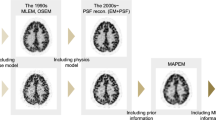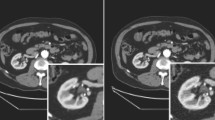Abstract
A new iterative reconstruction technique (NIRT) for positron emission computed tomography (PET), which uses transmission data for nonuniform attenuation correction, is described. Utilizing the general inverse problem theory, a cost functional which includes a noise term was derived. The cost functional was minimized using a weighted-least-square maximum a posteriori conjugate gradient (CG) method. The procedure involves a change in the Hessian of the cost function by adding an additional term. Two phantoms were used in a real data acquisition. The first was a cylinder phantom filled with uniformly distributed activity of 74 MBq of fluorine-18. Two different inserts were placed in the phantom. The second was a Hoffman brain phantom filled with uniformly distributed activity of 7.4 MBq of18F. Resulting reconstructed images were used to test and compare a new iterative reconstruction technique with a standard filtered backprojection (FBP) method. The results confirmed that NIRT, based on the conjugate gradient method, converges rapidly and provides good reconstructed images. In comparison with standard results obtained by the FBP method, the images reconstructed by NIRT showed better noise properties. The noise was measured as rms% noise and was less, by a factor of 1.75, in images reconstructed by NIRT than in the same images reconstructed by FBP. The distance between the Hoffman brain slice reconstructed by FBP and the perfect PET Hoffman brain slice created from the MRI image was 0.526, while the same distance for the Hoffman brain slice reconstructed by NIRT was 0.328. The NIRT method suppressed the propagation of the noise without visible loss of resolution in the reconstructed PET images.
Similar content being viewed by others
References
Palmer MR, Rogers JG, Bergstrom M, Beddoes MP, Pate BD. Transmission profile filtering for PET.IEEE Trans Nucl Sci 1986;1:478–481.
Dahlbom M, Hoffman EJ. Problems in signat-to-noise ratio for attenuation correction in high resolution. PET.IEEE Trans Nucl Sci 1987; 1: 288–293.
Tarantola A.Inverse problem theory. Amsterdam: Elsevier, 1987.
Geman S, Geman D. Stochastic relaxation, gibbs distribution, and Bayesian restoration of images.IEEE Trans Patt Anal Mach Intell 1984; PAMI-6: 721–741.
Lalush DS, Tsui BMW. A fast and stable maximum a posteriori conjugate gradient reconstruction algorithm.Med Phys 1995;22:1273–1284.
Sorenson JA, Phelps ME. Physics in nuclear medicine. Philadelphia: Saunders; 1987: 416–419.
Huseman RH, Gullberg GR, Budinger TF.User manual; Donner algorithms for reconstruction tomography. Berkeley, Calif.: 1977.
Andersson JLR. A rapid and accurate method to realign PET scans utilizing image edge information.J Nucl Med 1995; 36: 657–669.
Lalush DS, Tsui BMW. MAP-EM and WLS-MAP-CG reconstruction methods for transmission imaging in cardiac SPECT. Proceedings of the IEEE Nuclear Science Symposium and Medical Imaging Conference, San Francisco, Calif. 1993: 1174–1178.
Barret HH, Swindell W.Radiological imaging: the theory of image formation, detection, and processing. New York: Academic Press; 1981; 597–600.
Ortega JW, Reinbolt WC. Iterative solution of nonlinear equations of several variables. New York: Pergamon, 1970.
Kawata S, Nalcioglu O. Constrained iterative reconstruction by the conjugate gradient method.IEEE Trans Med Imag 1985; MI-4: 65–71.
Clinthorne NH, Pan T-S, Chiao P-C, Rogers WL, Stamos JA. Preconditioning methods for improved convergence rates in iterative reconstructions.IEEE Trans Med Imag 1993; 12: 78–83.
Xu XL, Liow JS, Strother SC. Iterative algebraic algorithms for emission computed tomography: a unified framework and its application to positron emission tomography.Med Pys 1993;20:1675–1684.
Nakamura O, Kawata S, Minami S. Optical microscope tomography. II. Non-negative constrain by a gradient-projection method.J Opt Soc Am 1988; 5: 554–561.
Formiconi AR, Pupi A, Passeri A. Compensation of spatial system response in SPECT with conjugate gradient reconstruction technique.Phys Med Biol 1989; 34: 69–83.
Author information
Authors and Affiliations
Rights and permissions
About this article
Cite this article
Knešaurek, K., Machac, J., Vallabhajosula, S. et al. A new iterative reconstruction technique for attenuation correction in high-resolution positron emission tomography. Eur J Nucl Med 23, 656–661 (1996). https://doi.org/10.1007/BF00834527
Received:
Revised:
Issue Date:
DOI: https://doi.org/10.1007/BF00834527




